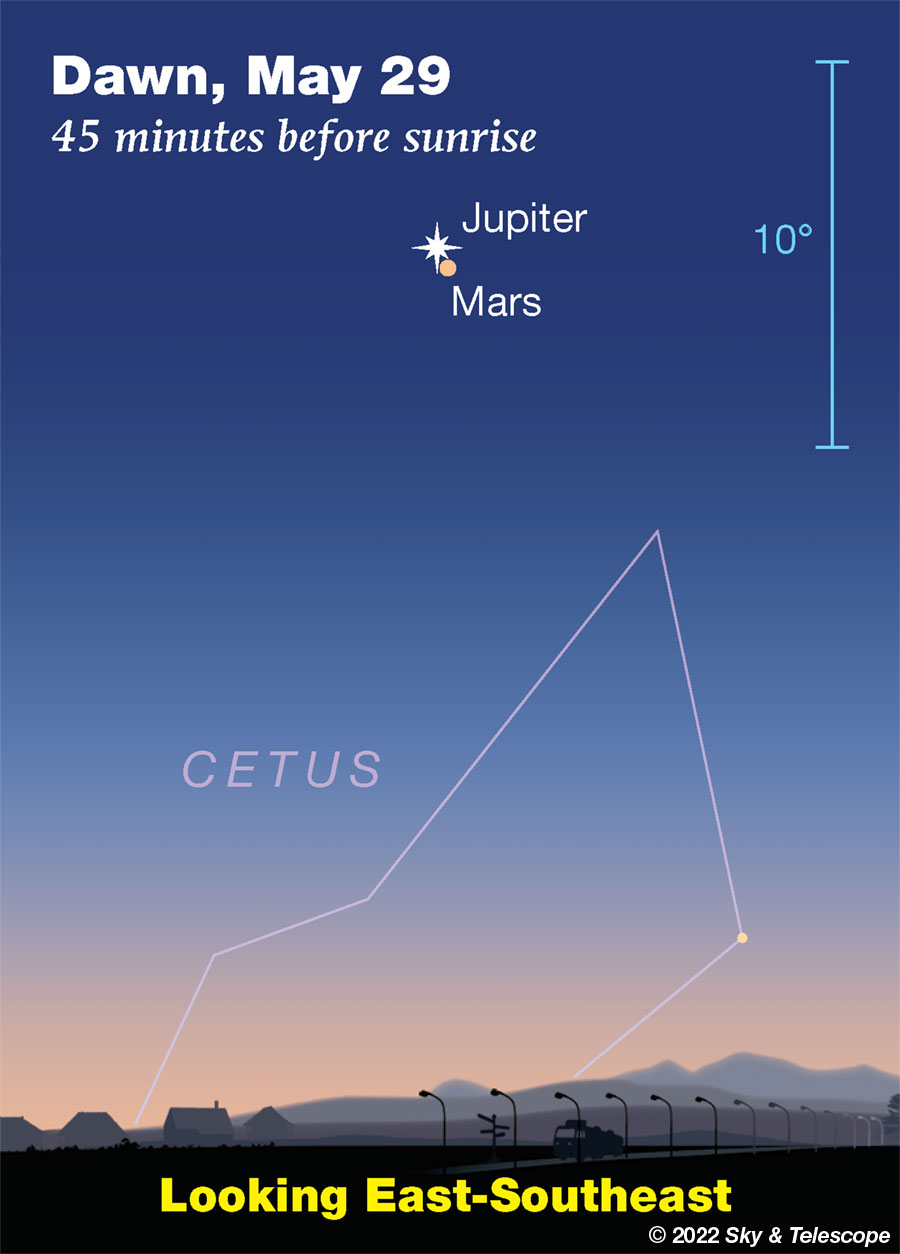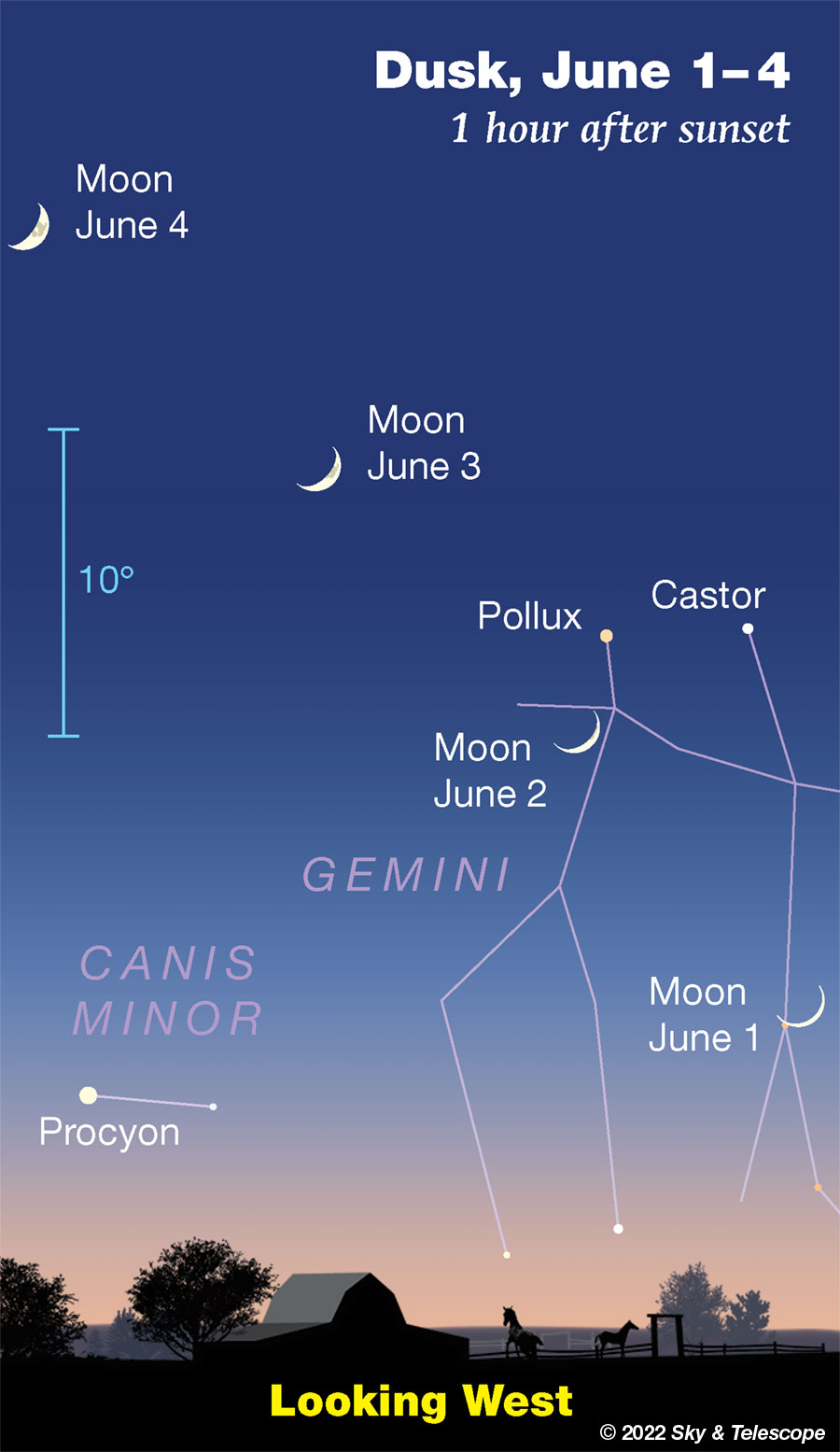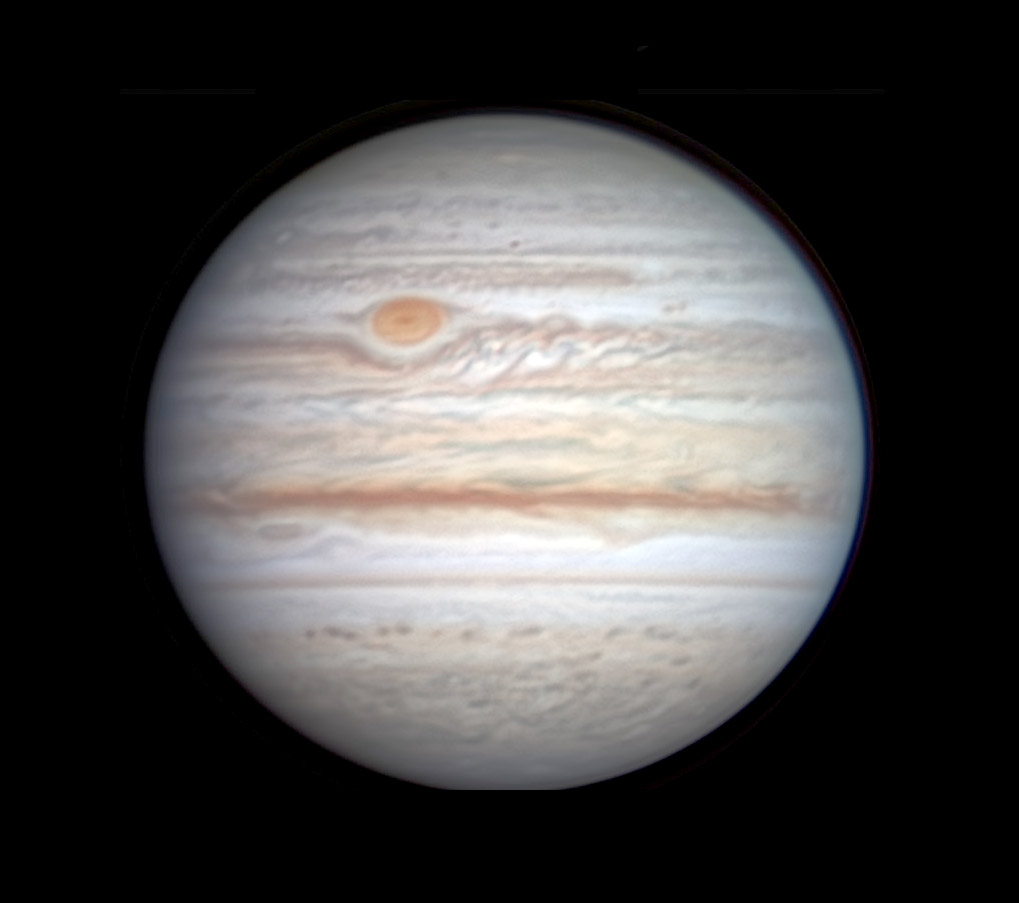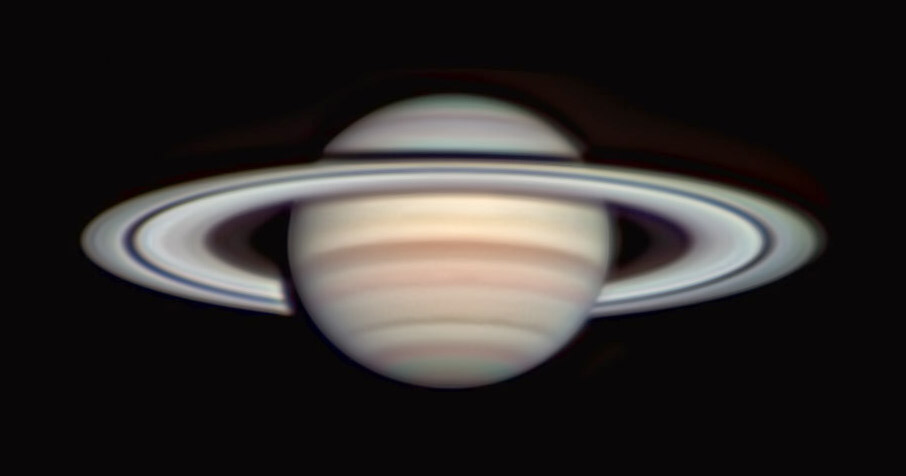FRIDAY, MAY 27
■ Bright Capella sets low in the northwest fairly soon after dark these evenings; how soon depends on your latitude. That leaves Vega and Arcturus as the brightest stars in the evening sky. Vega shines in the east-northeast. Arcturus is now very high toward the south.
A third of the way from Arcturus down to Vega, look for semicircular Corona Borealis, with 2nd-magnitude Alphecca as its one moderately bright star.
Two thirds of the way from Arcturus to Vega is the dim Keystone of Hercules, now lying almost level.
Use binoculars or a telescope to examine the Keystone's top edge. A third of the way from its left end to the right is 6th-magnitude M13, one of Hercules's two great globular star clusters. In binoculars it's a tiny glowing cotton ball. A 4- or 6-inch scope begins to resolve some of its speckliness. Located 22,000 light-years away high above the plane of the Milky Way, it consists of several hundred thousand stars in a swarm only about 140 light-years wide.
SATURDAY, MAY 28
■ Have you ever seen Alpha Centauri?! At declination –61° our brilliant, magnitude-zero neighbor star is permanently out of sight if you live north of latitude 29°. But if you're at the latitude of San Antonio, Orlando, or points south, Alpha Cen skims just above your true southern horizon for a little while late these evenings.
When to look for it? Just about when Alpha Librae, the lower-right of the two brightest stars of Libra, is due south over your landscape. At that time, drop your gaze down from there!
■ Bright Jupiter and fainter Mars are in conjunction, 0.6° apart, in early dawn Sunday morning May 29th as shown below. Look east-southeast. Binoculars help as dawn brightens.

SUNDAY, MAY 29
■ For much of the spring at mid-northern latitudes, the Milky Way lies right down out of sight all around the horizon. But watch the east now. The rich Cepheus-Cygnus-Aquila stretch of the Milky Way starts rising up all across the east late these nights, earlier and higher every week.
A hint for the light-polluted: It runs horizontally under Vega, right through the lower part of the Summer Triangle.
MONDAY, MAY 30
■ Strong new meteor shower tonight?? A stream of meteoroids from the broken-up periodic comet Schwassman-Wachmann 3 may produce many slow meteors in the sky tonight. They'll trace back to a radiant (perspective point of origin) near Arcturus — not Tau Herculis as originally assumed. Meteor researchers predict that any activity should last for just a few hours centered on 5:00 UT May 31st (1 a.m. May 31st EDT; 10 p.m. May 30th PDT). The event will be either "all or nothing," suggests Bill Cooke of NASA’s Meteoroid Environment Office. There will be no Moon.
See Joe Rao's article on page 34 of the May Sky & Telescope and his New Update on a Possible Outburst of Meteors online. His original research paper: Will Comet 73P/Schwassman-Wachmann 3 produce a meteor outburst in 2022?
The International Meteor Organization has a page set up that will display the shower's activity profile coming together as the group's meteor counters (who use the same standard observing methods so their counts will be inter-comparable) submit their post-observing reports.
■ New Moon (exact at 7:30 a.m. EDT on this date).
TUESDAY, MAY 31
■ Constellations seem to twist around fast when they pass your zenith — if you compare them to the direction "down." Just a week and a half ago, the Big Dipper floated horizontally in late twilight an hour after sunset (as seen from 40° north latitude). Now it's angled diagonally at that time. In just another week and a half it will be hanging straight down by its handle!
WEDNESDAY, JUNE 1
■ As twilight fades, look low in the west for the thin crescent Moon. It's in lower Gemini down under Pollux and Castor, as shown below.
Look left of the Moon by 25° (roughly 2½ fists at arm's length) for Procyon. Shown below is how they'll appear from latitude 40° in North America, for instance New York and Denver. From the southern U.S., Procyon will appear higher than it does here. From higher latitudes, Procyon will appear lower than shown here.

Other lunar-month counting systems are also used. The one boasting the highest count is the Hebrew Lunation Number, starting with the zero mark of the Hebrew calendar on October 7, 3761 BC. We're beginning Hebrew Lunation Number 72,464.
A lunar month (synodic month) averages 29.530575 days long. By comparison, our civil calendar months, ranging from 28 to 31 days, average 30.436875 days long in the Gregorian calendar now in use. This means that any given phase of the Moon occurs about one day earlier each calendar month on average.
THURSDAY, JUNE 2
■ Spot the crescent Moon in the west after sunset, as shown above. How soon, as twilight fades, can you first make out Pollux above the Moon, then Castor to the right of Pollux? Pollux is the brighter one at magnitude 1.15, while Castor is magnitude 1.58 (the combined magnitude of Castor A and B; it's a telescopic double). In other words, Castor is only 67% as bright as Pollux: one third dimmer.
So, for how many minutes does twilight have to fade from when you first detect Pollux until you first detect Castor?
FRIDAY, JUNE 3
■ Now the growing Moon shines upper left of Pollux and Castor (by about one fist) as shown above.
■ After dark, Vega shines as the brightest star very high in the east. Barely lower left of it is 4th-magnitude Epsilon Lyrae, the Double-Double. Epsilon forms one corner of a roughly equilateral triangle with Vega and Zeta Lyrae. The triangle is less than 2° on a side, hardly the width of your thumb at arm's length.
Binoculars easily resolve Epsilon. And a 4-inch telescope at 100× or more should resolve each of Epsilon's wide components into a tight pair.
Zeta Lyrae is also a double star for binoculars; much tougher, but plainly resolved in any telescope.
Delta Lyrae, below Zeta, is a much wider and easier binocular pair, orange and blue.
SATURDAY, JUNE 4
■ After dark, the crescent Moon forms a long isosceles (two sides equal) triangle with Regulus and Gamma Leonis (a little fainter) to the Moon's upper left. The Moon is at the long end of the triangle.
Tomorrow evening the triangle will be much shorter and flatter, but still isosceles.
This Week's Planet Roundup
Mercury is hidden deep in the glow of sunrise.
Venus (magnitude –4.0) rises soon after the beginning of dawn. Look for it just left of due east. It's roughly three fists at arm's length lower left of Jupiter.
Venus will continue to rise around the beginning of dawn from now all the way through August.
Mars and Jupiter, very different at magnitudes +0.7 and –2.2 respectively, shine close together before and during dawn in the east-southeast. They start the week in conjunction — exactly so on May 29th, when they'll be 0.6° apart as shown near the top of this page. Thereafter, little orange Mars slowly pulls away from brilliant Jupiter. You'll find it 3½° lower left of Jupiter by the morning of June 3rd.

Go lives in the Philippines at latitude 10° north, where the ecliptic runs at a high angle up from the horizon. Those of us at more northerly latitudes have a few more weeks to wait before Jupiter is high enough for sharp telescopic viewing in the beginning of dawn.
Saturn, magnitude +0.7, glows in eastern Capricornus a good 40° (about four fists) right or upper right of Jupiter before dawn. The little star 2° to Saturn's lower right is Delta Capricorni, magnitude 2.8.

Go images planets using a 14-inch Schmidt-Cassegrain scope on his apartment balcony, a top-of-the-line astro video camera, and sophisticated image stacking and processing. Details are on his website.
Uranus is buried in the eastern dawn.
Neptune, magnitude 7.9, is some 9° west (right) of Jupiter before dawn begins.
All descriptions that relate to your horizon — including the words up, down, right, and left — are written for the world's mid-northern latitudes. Descriptions and graphics that also depend on longitude (mainly Moon positions) are for North America.
Eastern Daylight Time, EDT, is Universal Time minus 4 hours. (Universal Time is also called UT, UTC, GMT or Z time.)
Want to become a better astronomer? Learn your way around the constellations. They're the key to locating everything fainter and deeper to hunt with binoculars or a telescope.
This is an outdoor nature hobby. For an easy-to-use constellation guide covering the whole evening sky, use the big monthly map in the center of each issue of Sky & Telescope, the essential magazine of astronomy.
Once you get a telescope, to put it to good use you'll need a detailed, large-scale sky atlas (set of charts). The basic standard is the Pocket Sky Atlas (in either the original or Jumbo Edition), which shows stars to magnitude 7.6.

Next up is the larger and deeper Sky Atlas 2000.0, plotting stars to magnitude 8.5; nearly three times as many. The next up, once you know your way around, are the even larger Interstellarum atlas (stars to magnitude 9.5) or Uranometria 2000.0 (stars to magnitude 9.75). And be sure to read How to Use a Star Chart with a Telescope. It applies just as much to charts on your phone or tablet as to charts on paper.
You'll also want a good deep-sky guidebook. A beloved old classic is the three-volume Burnham's Celestial Handbook. An impressive more modern one is the big Night Sky Observer's Guide set (2+ volumes) by Kepple and Sanner.
Can a computerized telescope replace charts? Not for beginners, I don't think, and not on mounts and tripods that are less than top-quality mechanically, meaning heavy and expensive. And as Terence Dickinson and Alan Dyer say in their Backyard Astronomer's Guide, "A full appreciation of the universe cannot come without developing the skills to find things in the sky and understanding how the sky works. This knowledge comes only by spending time under the stars with star maps in hand."
![]() Audio sky tour. Out under the evening sky with your
Audio sky tour. Out under the evening sky with your
earbuds in place, listen to Kelly Beatty's monthly
podcast tour of the heavens above. It's free.
"The dangers of not thinking clearly are much greater now than ever before. It's not that there's something new in our way of thinking, it's that credulous and confused thinking can be much more lethal in ways it was never before."
— Carl Sagan, 1996
"Facts are stubborn things."
— John Adams, 1770
 6
6









Comments
Rod
May 28, 2022 at 10:25 am
For those using small telescopes to view the conjunction of Mars and Jupiter tomorrow morning, Ganymede shadow will be visible on Jupiter. Sunrise tomorrow at my location is 0545 EDT and weather looks excellent. I used Stellarium and Starry Night, checked the view. At 0445 EDT, Ganymede shadow will be on Jupiter during this conjunction. I will post an update tomorrow after viewing. At 71x and 111x, I should be able to see both Mars and Jupiter in the FOV along with Ganymede shadow on the planet.
You must be logged in to post a comment.
Rod
May 29, 2022 at 6:54 am
I was able to observe the Mars and Jupiter conjunction this morning.
[Observed 0400-0515 EDT/0800-0915 UT. Sunrise 0545 EDT/0945 UT. New Moon 30-May-2022 1130 UT. Ganymede shadow on Jupiter, ingress 0749 UT, egress 1100 UT (May issue of Sky & Telescope table, p. 51). Conjunction of Mars and Jupiter this morning close to 0.6-degree apart. Stellarium shows a bit more than 34 arcminute angular separation in Pisces. Enjoyable and excellent views using TeleVue 14-mm Delos (71x) with #58 Green filter and TeleVue 9-mm Nagler (111x) without filter. It was easier to place both Mars and Jupiter in the same FOV at 71x. The green filter allowed the black spot of Ganymede shadow distinct on Jupiter along with various clouds bands. All 4 Galilean moons visible but in the north up, mirror reverse view of the 90-mm refractor telescope. Viewing Mars and Jupiter together with green filter, Mars is green and not the ‘red planet’ Mars distinct orange-reddish 87.5% illuminated according to Stellarium 0.22.1 without the green filter. There were fainter stars in the 9th-11th magnitude range visible within about 0.5-degree of Mars position. Starry Night and Stellarium showed the stars. This was fun viewing Mars and Jupiter conjunction at 71x to 111x views seeing both planets in the FOV. Both planets easily seen together, especially at 71x. The distance between Mars and Jupiter while I observed, looked about an hour car drive distance between them Near and after 0445 EDT, the sky started brightening. 0500 EDT, some great horn owls were hooting in the woods. I hooted back, some rosters in a nearby chicken farm started crowing, and dogs in the area within 300 hundred yards started howling. By 0500 EDT/0900 UT, Ganymede shadow as the *black spot* easier to see as it moved across the face of Jupiter, without green filter. Weather clear skies, some cirrus, winds calm and temperature 14C. A very enjoyable morning observing Mars and Jupiter conjunction while Ganymede shadow moved across Jupiter.]
You must be logged in to post a comment.
mary beth
May 31, 2022 at 11:44 am
Hi Rod I really enjoyed this report! Got a real chuckle out of the driving distance between the planets! So nice you could see them both in one field of vision. I think the dogs were howling because you did not let them come look through the telescope! It sounds like a delightful morning, I’m so glad you had clear skies and comfortable temperatures. Maybe you redeemed some of your bonus points?? If you have time can you please explain to me why you used the green filter?
You must be logged in to post a comment.
Rod
May 31, 2022 at 1:31 pm
mary beth, different filters bring out different details on planets and the Moon when viewing. Sites like Orion or TeleVue have info for using the different colors. Red and orange filters bring out details on Mars surface. My experience with the green filter on Jupiter, I can see more cloud banding details, the Great Red Spot is easier to see and when Galilean moons are in shadow passages, the small black or dark spots are easier to see on Jupiter. My 10-inch Newtonian operating with TeleVue 9-mm Nagler at 133x using green filter provides some excellent details.
You must be logged in to post a comment.
mary beth
May 29, 2022 at 2:37 pm
“Astronomy and astronomers are playing an important part in the war chiefly along the two lines which have always presented fundamentally stellar problems - direction and time. But the main advances in astronomy in these last four years have been made in spite of the war.”
Astronomy in a World at War by A. Vibert Douglas, President of the Royal Astronomical Society of Canada, January 21, 1944
Happy Decoration/Memorial Day (May 30) to everyone! We remember with grateful hearts all those who gave their lives for our freedom. May God rest their souls.
You must be logged in to post a comment.
Rod
May 29, 2022 at 8:23 pm
amen.
You must be logged in to post a comment.
You must be logged in to post a comment.